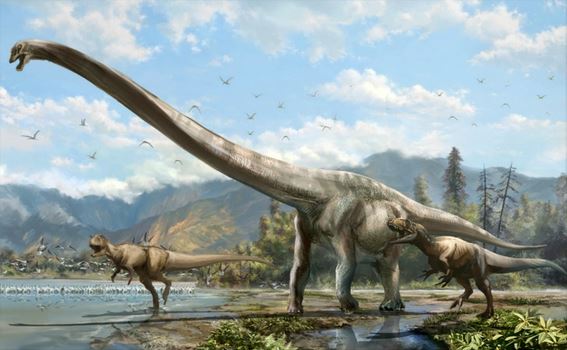A new species of dinosaur that existed 160 million years ago with a super-long neck has been discovered from fossil remains recovered in China. The animal’s neck measured half the length of its 15-meter long body.
The species was discovered by a team of paleontologists from the University of Alberta, Canada, including professor Philip Currie, Ph.D. student Tatsuto Miyashita, and former master’s student Lida Xing.
The findings have been published in the latest issue of the Journal of Vertebrate Paleontology (citation below).
The Late Jurassic species has been named Qijianglong (pronounced: CHI-jyang-lon), which means Dragon of Qijiang. It was discovered near Qijiang City, close to Chongqing, Southwest China.

Artist’s conception of Qijianglong being chased by two carnivorous dinosaurs in southern China 160 million years ago. (Illustration: Lida Xing. Image: University of Alberta)
Construction workers found the fossil site in 2006, and diggers eventually came across a series of large neck vertebrae stretched out in the ground. Amazingly, the animal’s head was still attached.
“It is rare to find a head and neck of a long-necked dinosaur together because the head is so small and easily detached after the animal dies.”
The new species belongs to the mamenchisaurids group of dinosaurs, known for their very long necks, which could measure up to half the length of their bodies. Most sauropods (long-necked dinosaurs with long tails, small heads and thick, pillar-like legs) had necks only about one-third of their body-length.
Qijianglong, unlike other mamenchisaurids, had air-filled neck vertebrae, making them relatively light despite their massive size. Interlocking joints between the vertebrae suggest their necks were surprisingly stiff, being more flexible for vertical than sideways movements, similar to a construction crane.
Mr. Miyashita said:
“Qijianglong is a cool animal. If you imagine a big animal that is half neck, you can see that evolution can do quite extraordinary things.”
Mamenchisaurids have only been found in Asia. However, this latest discovery suggests there could be as many differences among mamenchisaurids as there are between long-necked dinosaurs globally.
Miyashita said:
“Qijianglong shows that long-necked dinosaurs diversified in unique ways in Asia during Jurassic times – something very special was going on in that continent. Nowhere else we can find dinosaurs with longer necks than those in China. The new dinosaur tells us that these extreme species thrived in isolation from the rest of the world.”
Why didn’t mamenchisaurids migrate to other continents?
The researchers believe that mamenchisaurids evolved into several different forms when other long-necked dinosaurs went extinct in Asia. “It is still a mystery why mamenchisaurids did not migrate to other continents,” Mr. Miyashita said.
Perhaps the dinosaurs were once geographically isolated as a result of a large barrier such as the sea, and lost in competition with invading species when the land connected again.
The Dragon of Qijiang is currently housed in a local museum in Qijiang. “China is home to the ancient myths of dragons. I wonder if the ancient Chinese stumbled upon a skeleton of a long-necked dinosaur like Qijianglong and pictured that mythical creature,” Mr, Miyashita commented.
Citation: “A new sauropod dinosaur from the Late Jurassic of China and the diversity, distribution, and relationships of mamenchisaurids,” Lida Xing, Tetsuto Miyashita, Jianping Zhang, Daqing Li, Yong Ye, Toru Sekiya, Fengping Wangf & Philip J. Currie. Journal of Vertebrate Paleontology. DOI:10.1080/02724634.2014.889701. Published online Jan 26, 2015.
Video – Discovery of ‘Dragon’ dinosaur

